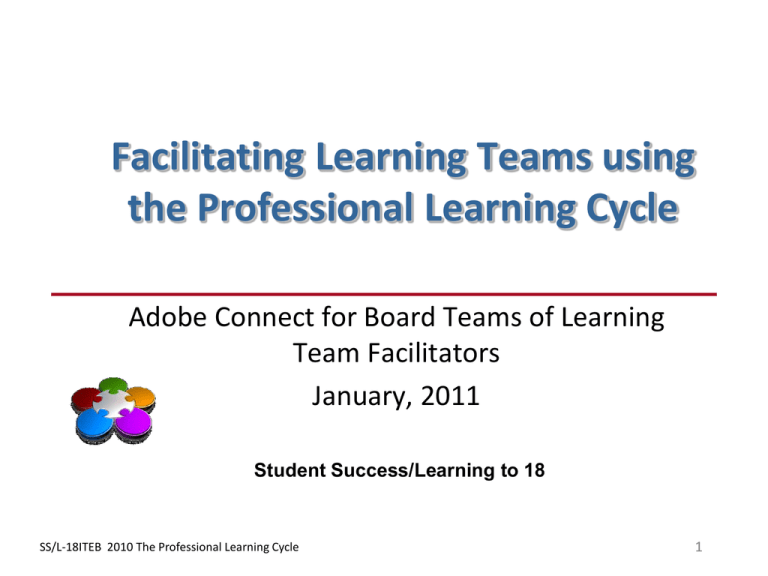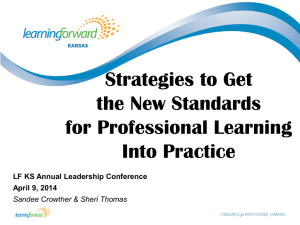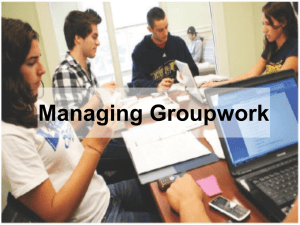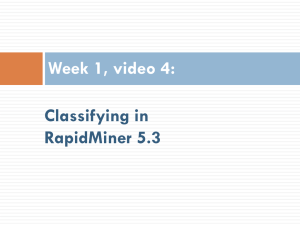PPT - EduGAINS
advertisement

Facilitating Learning Teams using the Professional Learning Cycle Adobe Connect for Board Teams of Learning Team Facilitators January, 2011 Student Success/Learning to 18 SS/L-18ITEB 2010 The Professional Learning Cycle 1 Session Materials PowerPoint slide summary Handout 1: Facilitation Approaches and Standards Handout 2: A Professional Learning Cycle Handout 3: Plan - Data Sets Handout 4: Observe - Shared Practice Scenarios Handout 5: Collaborative Inquiry Continuum See confirmation email or http://community.elearningontario.ca/index-en.asp SS/L-18ITEB 2010 The Professional Learning Cycle 2 Poll I have facilitated learning teams using a Professional Learning Cycle: 1. never 2. as a shared responsibility with others 3. a few times 4. many times SS/L-18ITEB 2010 The Professional Learning Cycle 3 A rose by any other name… Collaborative Inquiry e.g. •TLCP •Action Research •Lesson Study The Professional Learning Cycle is driven by student learning needs. SS/L-18ITEB 2010 The Professional Learning Cycle 4 Professional Learning Cycle The goal of the Professional Learning Cycle Strategy is to increase student engagement and achievement by providing a process for professional learning that is driven and focused by student learning needs. SS/L-18ITEB 2010 The Professional Learning Cycle 5 Agenda Minds On Poll Welcome and Introductions Purpose and Context Action Facilitation Approaches and Standards Complementary Roles Shared Practice PLAN ACT OBSERVE REFLECT Consolidation Reflection and Next Steps SS/L-18ITEB 2010 The Professional Learning Cycle 6 Session Purpose Share practice and build capacity in facilitating learning teams using the professional learning cycle Sharpen the focus on identifying and addressing student learning needs on an ongoing basis SS/L-18ITEB 2010 The Professional Learning Cycle 7 E-Protocols • Use signals (bottom left hand corner) • Use “Raise hand” to volunteer to speak • Identify yourself before speaking • Use the CHAT Pod to communicate with the whole group or privately with a colleague by selecting from the drop down menu • Mute your phone or polycom when not speaking to the large group (*6) SS/L-18ITEB 2010 The Professional Learning Cycle 8 Introductions SS/L-18ITEB 2010 The Professional Learning Cycle 9 Provincial Context: Core Priorities High Levels of Student Achievement Reducing the Gaps in Student Achievement Increased Public Confidence in Our Publicly Funded Schools SS/L-18ITEB 2010 The Professional Learning Cycle 10 Student Success/Learning to 18 Focusing on the Core Priorities, Grades 7-12 Programs (e.g., SHSM) Interventions (e.g., Credit Recovery) Effective Instruction (i.e., DI Professional Learning Strategy) ALL SOME Necessary for some; good for all SS/L-18ITEB 2010 The Professional Learning Cycle 11 School Effectiveness Framework SS/L-18ITEB 2010 The Professional Learning Cycle 12 School Effectiveness Framework School and Classroom Leadership • 2.4 Job-embedded and inquiry-based professional learning builds capacity, informs instructional practice and contributes to a culture of learning SS/L-18ITEB 2010 The Professional Learning Cycle 13 Learning Teams Professional learning team meetings have one primary purpose: improved teaching and learning in an area of identified student need. The aim is… to provide a way for teachers to become increasingly accomplished instructors for the Source: ultimate benefit of students … not The Evolution of a (simply) to develop professional Professional Learning Team, Tools for Schools learning teams. (NSDC), Nov./ Dec. 2008 SS/L-18ITEB 2010 The Professional Learning Cycle 14 Implications of School-based Inquiry Teams Using a collaborative inquiry model: • (Shifts teacher) attribution of improved student performance to … teaching rather than external causes • (Gives focus to) an academic problem long enough to develop an instructional solution SOURCE: Moving the Learning of Teaching Closer to Practice: Teacher Education Implications of School-based Inquiry Teams 1, Ronald Gallimore, LessonLab Research Institute & UCLA, May 2009 SS/L-18ITEB 2010 The Professional Learning Cycle 15 Agenda Minds On Poll Welcome and Introductions Purpose and Context Action Facilitation Approaches and Standards Complementary Roles Shared Practice PLAN ACT OBSERVE REFLECT Consolidation Reflection and Next Steps SS/L-18ITEB 2010 The Professional Learning Cycle 16 Knowing the Learner POLL • Think about your experience as a facilitator and select the option that best describes you as a facilitator: A. B. C. D. E. Mickey Mouse The Librarian Einstein Elmo Eeyore SS/L-18ITEB 2010 The Professional Learning Cycle 17 Facilitation Approaches and Standards Read A and B: A. Approaches – Instructional and Facilitative B. Standards SS/L-18ITEB 2010 The Professional Learning Cycle HANDOUT 1 18 Facilitation Approaches and Standards: Board Groups 1. For either A. Approaches or B. Standards, think about examples of when you have attended (might attend) to one of these aspects of facilitation and how you did it. 2. Raise your hand when you are ready to share a comment or example. 19 Facilitator Role The facilitator . . . •leads the processes used in a meeting, •choreographs the energy within the group, •maintains a focus on one content and one process at a time. Adapted from: Garmston and Wellman, The Adaptive School, p.27 20 Collaborative Inquiry Continuum When meeting as a learning team, our work together is facilitated… HANDOUT 2 SS/L-18ITEB 2010 The Professional Learning Cycle 21 21 Complementary Roles Think: How do facilitators/ informal leaders and formal leaders support each other in their roles? SS/L-18ITEB 2010 The Professional Learning Cycle 22 Informal and Formal Leaders Informal Formal • Instructional leadership • Operational and instructional leadership • Articulate vision • Role of authority • Set direction • Roles are a function of relationships, influence and activities • Lead, participate and share – activity-based and expertise driven • Organize, manage, design and build collaborative processes and communities • Support teachers in learning – advocacy, time and resources, delegate, distribute power • Create conditions for collaboration Katz, Earl, Jaafar (2009). Building and Connecting Learning Communities, p.61 SS/L-18ITEB 2010 The Professional Learning Cycle 23 Leadership and Student Learning After teaching, the second most influential factor on student learning is leadership (shared; formal and informal). Most-effective leadership dimension: promoting and participating in teacher learning and development Vivian Robinson, 2007, School Leadership and Student Outcomes: Identifying What Works and Why in Earl and Katz, Creating a Culture of Inquiry in Blankstein, 2010: Data Enhanced Leadership SS/L-18ITEB 2010 The Professional Learning Cycle 24 A Professional Learning Cycle SS/L-18ITEB 2010 The Professional Learning Cycle HANDOUT 3 25 25 Collaborative Inquiry … a way of ensuring that collaboration goes beyond casual story swapping and becomes true, intentional joint work that results in new understandings that will move practice forward Katz, Earl & Jaafar, (2009). Building and Connecting Learning Communities, p.74. SS/L-18ITEB 2010 The Professional Learning Cycle 26 26 Professional Learning Cycle STUDENT LEARNING EDUCATOR LEARNING For each unit/module: PLAN • examine student data and work to identify areas of need • determine/access professional learning in order to address areas of student need and to differentiate to reach all ACT/OBSERVE • implement, adjust, engage in professional learning, share practice REFLECT • examine student data and work to determine impact, lessons learned, next steps for student and educator learning SS/L-18ITEB 2010 The Professional Learning Cycle 27 DATA / EVIDENCE-BASED ALIGNED Depth Board (BIP) School (SIP) Classroom (planning for teaching and learning) collaborative inquiry – professional learning cycle SS/L-18ITEB 2010 The Professional Learning Cycle 28 Example Literacy: Writing Board (BIP) Literacy: Writing Gr. 9 & 10 Applied/Open Literacy: Writing Gr. 9 Tech Ed and Visual Arts, Gr. 10 Computer Studies: Common Assessment area Expression and Organization of Ideas (Achievement Chart) SS/L-18ITEB 2010 The Professional Learning Cycle School (SIP) Classroom (planning for teaching and learning) Professional Learning Cycle (collaborative inquiry) 29 PLAN Student learning need focuses educator learning SS/L-18ITEB 2010 The Professional Learning Cycle 30 30 PLAN In the CHAT Pod, please list: 1. one or more examples of data/evidence your team could examine to determine a student learning need 2. the identified student need EXAMPLE: Evidence: - Assignment completion; - E, G, S, Ns for ‘independent work’ learning skill; - Attendance SS/L-18ITEB 2010 The Professional Learning Cycle Need: increased student engagement 31 PLAN - Debrief 1. Read through the examples 2. What similarities and differences do you notice? 3. Questions? (Raise your hand) SS/L-18ITEB 2010 The Professional Learning Cycle 32 Precise Focus on Student Learning Needs (Closing the Gap) For each unit/module consider: • specific groups of students (e.g., in the 40-59% range, disengaged and underachieving OR • 4 or 5 students with varied needs STUDENT LEARNING TEACHER LEARNING • Who are they? • Why does each group/student typically achieve in this range? • How can these needs be addressed in the upcoming unit/module? • How do these needs relate to the needs of others in the class? • How can instruction be differentiated to reach all learners? SS/L-18ITEB 2010 The Professional Learning Cycle 33 Data Set Topics HANDOUT 3 Select a data set to examine: Data Set 1: Career Studies Data Set 2: Cross-curricular - Reading Readiness Data Set 3: Math - Solving Linear Equations Data Set 4: Cooperative Education - Reflection SS/L-18ITEB 2010 The Professional Learning Cycle 34 Data Sets Based on the data/evidence: • Identify an area of student need • Determine a focus for educator learning • What evidence would indicate that the need has been addressed? • Note your responses in the Chat Pod for that Data Set. SS/L-18ITEB 2010 The Professional Learning Cycle HANDOUT 3 35 Collaborative Inquiry Continuum When meeting as a learning team, our work together… HANDOUT 2 SS/L-18ITEB 2010 The Professional Learning Cycle 36 ACT Implementing strategies to meet student needs SS/L-18ITEB 2010 The Professional Learning Cycle 37 Are Canadian Youth Engaged at School? • Although many students are engaged at school, overall levels of social and academic engagement are quite low. • Levels of intellectual engagement – which tap into students’ sense of interest, feelings about the relevance of school work, and motivation to do well in class – are significantly lower than levels of social and academic engagement. • Levels of student engagement decline steadily throughout the middle and secondary school grades. http://www.cea-ace.ca/res.cfm?subsection=wdy SS/L-18ITEB 2010 The Professional Learning Cycle 38 A Focus on Instruction Motivation high effect size John Hattie (2008), Visible Learning, p.240 … motivation is highest when students are competent, have sufficient autonomy, set worthwhile goals, get feedback, and are affirmed by others. Hattie, Visible Learning, p.48 SS/L-18ITEB 2010 The Professional Learning Cycle 39 A Focus on Instruction Teachers are among the most powerful influences in learning…. John Hattie (2008), Visible Learning, p.240 … teachers using particular teaching methods, teachers with high expectations for all students, and teachers who have created positive studentteacher relationships … are more likely to have above average effects on student achievement. Hattie, Visible Learning, p.126 SS/L-18ITEB 2010 The Professional Learning Cycle 40 40 A Focus on Instruction SS/L-18ITEB SS/L-18ITEB 2010 The Professional 2010 Differentiated Learning Cycle Instruction Professional Learning Strategy 41 ACT – Four Corners 1. What is the role of formal and informal leaders in the ACT phase? 2. How might the ACT phase look different for different team members? 3. What logistical challenges do you foresee and how might these be overcome? 4. Identify ways to assist or support teachers as they adjust their instruction based on what they learn about their students. SS/L-18ITEB 2010 The Professional Learning Cycle 42 ACT ACT––Four Four Corners Corners • Select a question to discuss as a team or to think about as an individual. • Raise your hand if you would like to share a point with the large group. SS/L-18ITEB 2010 The Professional Learning Cycle 43 Collaborative Inquiry Continuum When meeting as a learning team, our work together… HANDOUT 2 SS/L-18ITEB 2010 The Professional Learning Cycle 44 44 OBSERVE Sharing instructional practice to monitor student learning and enhance educator learning SS/L-18ITEB 2010 The Professional Learning Cycle 45 45 Student Work “One of the most powerful ways to ensure that any (learning team) stays focused – whether within or across schools – is by making sure that it is anchored by actual student work.” p. 76 “Having actual student work is at the center of the collaborative inquiry exercise. It creates the opportunity for evidence-driven, focused professional learning conversations.” p. 76 SS/L-18ITEB 2010 The Professional Learning Cycle Katz, Earl, Jaafar, 2009 (Corwin) 46 OBSERVE: E-Group Scenarios 1. Select a scenario in which you are interested or have had previous experience. 2. Note your response/thoughts to the question in the chat pod for that Scenario. 3. Raise your hand if you would like to share with the whole group. SS/L-18ITEB 2010 Differentiated Instruction Professional Learning Strategy HANDOUT 4 47 Collaborative Inquiry Continuum When meeting as a learning team, our work together… HANDOUT 2 SS/L-18ITEB 2010 The Professional Learning Cycle 48 48 REFLECT Examining evidence to reflect on student and educator learning SS/L-18ITEB 2010 The Professional Learning Cycle 49 Reflect Key Questions for Reflection • • How might you assist your learning team in determining whether the strategies they have used have made a difference? How will you help members of your learning team determine what they have learned and, based on student learning needs, their next steps for professional learning? SS/L-18ITEB 2010 The Professional Learning Cycle 50 Collaborative Inquiry Continuum HANDOUT 2 When meeting as a learning team, our work together… SS/L-18ITEB 2010 The Professional Learning Cycle 51 Agenda Minds On Poll Welcome and Introductions Purpose and Context Action Facilitation Approaches and Standards Complementary Roles Shared Practice PLAN ACT OBSERVE REFLECT Consolidation Reflection and Next Steps SS/L-18ITEB 2010 The Professional Learning Cycle 52 Consolidation Reflection • Think about something that has resonated for you or that is particularly relevant for your board team. • Raise your hand if you would like to share with the large group. Next Steps • Meet as a team to review the session and plan next steps. SS/L-18ITEB 2010 The Professional Learning Cycle 53 Thank you. anne.clifton@ontario.ca karen.greenham@ontario.ca linda.staudt@ontario.ca shawna.eby@ontario.ca demetra.saldaris@ontario.ca (manager) SS/L-18ITEB 2010 The Professional Learning Cycle 54








